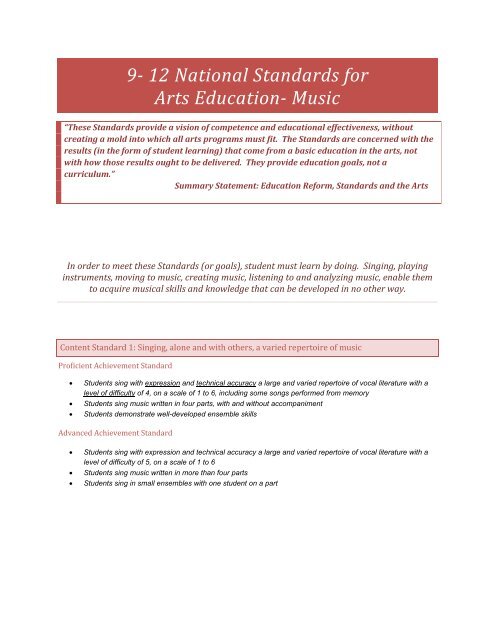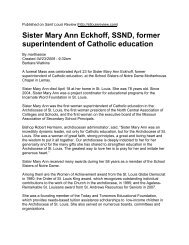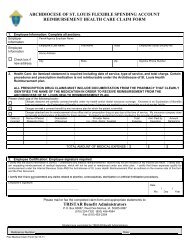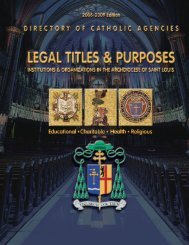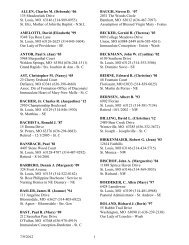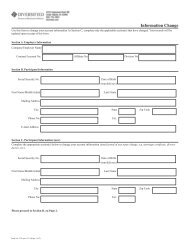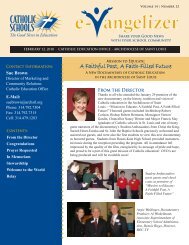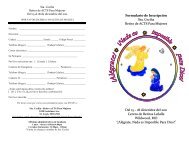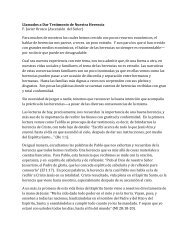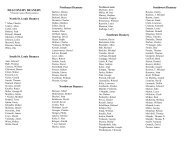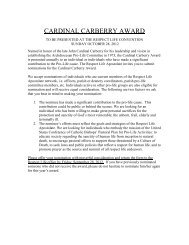Grades 9 -12 National Standards for Arts Education- Music
Grades 9 -12 National Standards for Arts Education- Music
Grades 9 -12 National Standards for Arts Education- Music
Create successful ePaper yourself
Turn your PDF publications into a flip-book with our unique Google optimized e-Paper software.
9 <strong>12</strong> <strong>National</strong> <strong>Standards</strong> <strong>for</strong><strong>Arts</strong> <strong>Education</strong> <strong>Music</strong>“These <strong>Standards</strong> provide a vision of competence and educational effectiveness, withoutcreating a mold into which all arts programs must fit. The <strong>Standards</strong> are concerned with theresults (in the <strong>for</strong>m of student learning) that come from a basic education in the arts, notwith how those results ought to be delivered. They provide education goals, not acurriculum.”Summary Statement: <strong>Education</strong> Re<strong>for</strong>m, <strong>Standards</strong> and the <strong>Arts</strong>In order to meet these <strong>Standards</strong> (or goals), student must learn by doing. Singing, playinginstruments, moving to music, creating music, listening to and analyzing music, enable themto acquire musical skills and knowledge that can be developed in no other way.Content Standard 1: Singing, alone and with others, a varied repertoire of musicProficient Achievement Standard• Students sing with expression and technical accuracy a large and varied repertoire of vocal literature with alevel of difficulty of 4, on a scale of 1 to 6, including some songs per<strong>for</strong>med from memory• Students sing music written in four parts, with and without accompaniment• Students demonstrate well-developed ensemble skillsAdvanced Achievement Standard• Students sing with expression and technical accuracy a large and varied repertoire of vocal literature with alevel of difficulty of 5, on a scale of 1 to 6• Students sing music written in more than four parts• Students sing in small ensembles with one student on a part
Content Standard 2: Per<strong>for</strong>ming on instruments, alone and with others, a varied repertoire of musicProficient Achievement Standard:• Students per<strong>for</strong>m with expression and technical accuracy a large and varied repertoire of instrumentalliterature with a level of difficulty of 4, on a scale of 1 to 6• Students per<strong>for</strong>m an appropriate part in an ensemble, demonstrating well-developed ensemble skills• Students per<strong>for</strong>m in small ensembles with one student on a partAdvanced Achievement Standard:• Students per<strong>for</strong>m with expression and technical accuracy a large and varied repertoire of instrumentalliterature with a level of difficulty of 5, on a scale of 1 to 6Content Standard 3: Improvising melodies, variations, and accompanimentsProficient Achievement Standard:• Students improvise stylistically appropriate harmonizing parts• Students improvise rhythmic and melodic variations on given pentatonic melodies and melodies in major andminor keys• Students improvise original melodies over given chord progressions, each in a consistent style, meter, andtonalityAdvanced Achievement Standard:• Students improvise stylistically appropriate harmonizing parts in a variety of styles• Students improvise original melodies in a variety of styles, over given chord progressions, each in aconsistent style, meter, and tonalityContent Standard 4: Composing and arranging music within specified guidelinesProficient Achievement Standard:• Students compose music in several distinct styles, demonstrating creativity in using the elements of music <strong>for</strong>expressive effect• Students arrange pieces <strong>for</strong> voices or instruments other than those <strong>for</strong> which the pieces were written in waysthat preserve or enhance the expressive effect of the music• Students compose and arrange music <strong>for</strong> voices and various acoustic and electronic instruments,demonstrating knowledge of the ranges and traditional usages of the sound sourcesAdvanced Achievement Standard:• Students compose music, demonstrating imagination and technical skill in applying the principles ofcomposition
Content Standard 5: Reading and notating musicProficient Achievement Standard:• Students demonstrate the ability to read an instrumental or vocal score of up to four staves by describing howthe elements of music are used• Students who participate in a choral or instrumental ensemble or class sight-read, accurately andexpressively, music with a level of difficulty of 3, on a scale of 1 to 6Advanced Achievement Standard:• Students demonstrate the ability to read a full instrumental or vocal score by describing how the elements ofmusic are used and explaining all transpositions and clefs• Students interpret nonstandard notation symbols used by some 20th-century composers• Students who participate in a choral or instrumental ensemble or class sight-read, accurately andexpressively, music with a level of difficulty of 4, on a scale of 1 to 6Content Standard 6: Listening to, analyzing, and describing musicProficient Achievement Standard:• Students analyze aural examples of a varied repertoire of music, representing diverse genres and cultures,by describing the uses of elements of music and expressive devices• Students demonstrate extensive knowledge of the technical vocabulary of music• Students identify and explain compositional devices and techniques used to provide unity and variety andtension and release in a musical work and give examples of other works that make similar uses of thesedevices and techniquesAdvanced Achievement Standard:• Students demonstrate the ability to perceive and remember music events by describing in detail significantevents (e.g., fugal entrances, chromatic modulations, developmental devices) occurring in a given auralexample• Students compare ways in which musical materials are used in a given example relative to ways in whichthey are used in other works of the same genre or style• Students analyze and describe uses of the elements of music in a given work that make it unique, interesting,and expressiveContent Standard 7: Evaluating music and music per<strong>for</strong>mancesProficient Achievement Standard:• Students evolve specific criteria <strong>for</strong> making in<strong>for</strong>med, critical evaluations of the quality and effectiveness ofper<strong>for</strong>mances, compositions, arrangements, and improvisations and apply the criteria in their personalparticipation in music• Students evaluate a per<strong>for</strong>mance, composition, arrangement, or improvisation by comparing it to similar orexemplary modelsAdvanced Achievement Standard:• Students evaluate a given musical work in terms of its aesthetic qualities and explain the musical means ituses to evoke feelings and emotions
Content Standard 8: Understanding relationships between music, the other arts, and disciplinesoutside the artsProficient Achievement Standard:• Students explain how elements, artistic processes (such as imagination or craftmanship), and organizationalprinciples (such as unity and variety or repetition and contrast) are used in similar and distinctive ways in thevarious arts and cite examples• Students compare characteristics of two or more arts within a particular historical period or style and citeexamples from various cultures• Students explain ways in which the principles and subject matter of various disciplines outside the arts areinterrelated with those of music (e.g., language arts: compare the ability of music and literature to conveyimages, feelings, and meanings; physics: describe the physical basis of tone production in string, wind,percussion, and electronic instruments and the human voice and of the trans<strong>for</strong>mation and perception ofsound)Advanced Achievement Standard:• Students compare the uses of characteristic elements, artistic processes, and organizational principlesamong the arts in different historical periods and different cultures• Students explain how the roles of creators, per<strong>for</strong>mers, and others involved in the production andpresentation of the arts are similar to and different from one another in the various arts (e.g., creators:painters, composers, choreographers, playwrights; per<strong>for</strong>mers: instrumentalists, singers, dancers, actors;others: conductors, costumers, directors, lighting designers)Content Standard 9: Understanding music in relation to history and cultureProficient Achievement Standard:• Students classify by genre or style and by historical period or culture unfamiliar but representative auralexamples of music and explain the reasoning behind their classifications• Students identify sources of American music genres (e.g., swing, Broadway musical, blues) trace theevolution of those genres, and cite well-known musicians associated with them• Students identify various roles (e.g., entertainer, teacher, transmitter of cultural tradition) that musiciansper<strong>for</strong>m, cite representative individuals who have functioned in each role, and describe their activities andachievementsAdvanced Achievement Standard:• Students identify and explain the stylistic features of a given musical work that serve to define its aesthetictradition and its historical or cultural context• Students identify and describe music genres or styles that show the influence of two or more culturaltraditions, identify the cultural source of each influence, and trace the historical conditions that produced thesynthesis of influences


